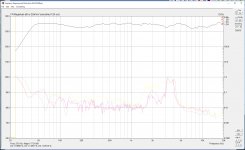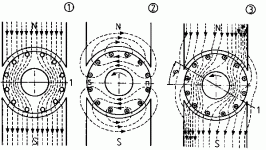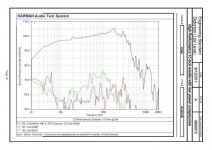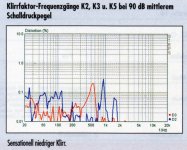i don't know if this explanation is correct but the shorting ring is intended to try and maintain the flux density over a wider area of voice coil motion to counter the back emf that would otherwise be introduced into the pole piece. ( i like to think of it as "lens correction")
does it succeed in reducing (dare i say it) "distortion" apparently so, but some would say "let see the spec's" others would say you "can't hear it".
falls into that apparently "irrelevant domain"
for me the circle of confusion becomes -- amp + speaker = ?
we generally can find or build good amps but when it comes to loudspeakers apparently not so much,(this thread is exploring that very thing) it's kind of a chicken/ egg thing for me.
if we have a good amp and we hang a reactive load to it what have we got?
the analogy of the transformer works, hang a reactive load on either side what have you got(-problems on one side affecting the other side)
we apparently can't tolerate amp distortion but can live with it in loudspeakers?
i contend that much of what we blame amps for starts in the loudspeaker!
does it succeed in reducing (dare i say it) "distortion" apparently so, but some would say "let see the spec's" others would say you "can't hear it".
falls into that apparently "irrelevant domain"
for me the circle of confusion becomes -- amp + speaker = ?
we generally can find or build good amps but when it comes to loudspeakers apparently not so much,(this thread is exploring that very thing) it's kind of a chicken/ egg thing for me.
if we have a good amp and we hang a reactive load to it what have we got?
the analogy of the transformer works, hang a reactive load on either side what have you got(-problems on one side affecting the other side)
we apparently can't tolerate amp distortion but can live with it in loudspeakers?
i contend that much of what we blame amps for starts in the loudspeaker!
anybody remember the debacle that started in the late 80's and into the early 90's?
there was a few "audio reporter/ reviewers"(one was playing on two teams) writing for different magazines that started the "Spec War's" long story short one mag died off and subsequent legal wrangling introduced the "don't give them something they can use against you mentality" which resulted in the disappearance/shrinking of the availability of detailed data.
there was a few "audio reporter/ reviewers"(one was playing on two teams) writing for different magazines that started the "Spec War's" long story short one mag died off and subsequent legal wrangling introduced the "don't give them something they can use against you mentality" which resulted in the disappearance/shrinking of the availability of detailed data.
Regarding armature reaction in motors, most has been written about rotating motors, not linear motors such as in loudspeakers. However, maybe a few links worth looking at to help develop some intuition on the subject:
Armature Reaction in Alternator or Synchronous Generator | Electrical4u
Effects of Armature Reaction - Remedies to Armature Reaction Effect
Effects of Armature Reaction – Electrical engineering interview questions
Regarding shorting rings for speakers, there are some AES articles, but not that I am aware of for free. However, there are some patents that may might be of interest:
Patent US6768806 - Shorting rings in dual-coil dual-gap loudspeaker drivers - Google Patents
Patent US5815587 - Loudspeaker with short circuit rings at the voice coil - Google Patents
https://www.google.com/patents/US7031489
Also, an illustration of the effect below:
Armature Reaction in Alternator or Synchronous Generator | Electrical4u
Effects of Armature Reaction - Remedies to Armature Reaction Effect
Effects of Armature Reaction – Electrical engineering interview questions
Regarding shorting rings for speakers, there are some AES articles, but not that I am aware of for free. However, there are some patents that may might be of interest:
Patent US6768806 - Shorting rings in dual-coil dual-gap loudspeaker drivers - Google Patents
Patent US5815587 - Loudspeaker with short circuit rings at the voice coil - Google Patents
https://www.google.com/patents/US7031489
Also, an illustration of the effect below:
Attachments
Last edited:
Hi Barry,
What I would like to see about the M2 drivers are the distortion figures at let's say 100dB/m,... Vac
Here ya go!
Please look carefully at the notes as the distortion levels are raised 20dB to retain some resolution on the graph.
I am interested in what conversation this will bring as I don't recall anyone else posting any real driver distortion measurements on this thread yet.
In my own comparative listening tests this driver flat smokes the good old revered by many JBL 2235 in every way. When you turn it up, it just gets louder, the sound quality doesn't change.
Barry.
Attachments
we generally can find or build good amps but when it comes to loudspeakers apparently not so much,(this thread is exploring that very thing) it's kind of a chicken/ egg thing for me.
Why do people think "loudspeakers" means only Rice-Kellogg cone drivers with no motional feedback?
The R-K pattern of shaking heavy cardboard in thin air makes as little sense as using a reciprocating internal combustion engine to drive a car. Yes, it can be done (I've seen it) but it's not smart engineering.
If distortion in sound is the topic of this thread, electrostatic speakers should be considered too.
B.
Here ya go!
Please look carefully at the notes as the distortion levels are raised 20dB to retain some resolution on the graph.
I am interested in what conversation this will bring as I don't recall anyone else posting any real driver distortion measurements on this thread yet.
In my own comparative listening tests this driver flat smokes the good old revered by many JBL 2235 in every way. When you turn it up, it just gets louder, the sound quality doesn't change.
Barry.
Interesting.
So, the 2nd harmonic peaks at 55dB @ 60Hz, which - relative to an SPL of 95dB at the same frequency - means -40dB = 1%
The 3rd harmonic peaks at 55dB also @ 500 and 600Hz, which - relative to an SPL of 100dB at the same frequencies - means -45dB = 0.56%
My own 15" woofer of choice, the Fostex FW405N, was measured by the reputable independent German magazine "Hobby Hi-Fi" - see attachment.
The 2nd and 3rd harmonics were measured to peak respectively at 0.3% and 0.2% (in both cases above 500Hz), while both components remain below 0.1% at all frequencies below 500Hz. (The figure caption reads: "Sensationally low distortion")
These measurements were carried out at a lower SPL of 90dB, so they are not directly comparable. But I think they still tend to indicate a better objective performance overall, especially w.r.t. the 2nd harmonic, which is lower by one full order of magnitude (0.1% vs 1%) in the low bass frequencies.
Be that as it may, it remains doubtful if any of this is really meaningful from the point of view of our listening perception. Published evidence seems to indicate that once a woofer's distortion is below a few %, then it no longer makes any audible difference...
Marco
Attachments
Those are very impressive harmonic distortion traces. And you are right that there are thresholds that, once crossed, you are just fine. Particularly with music and esp in bass, which is full of harmonics naturally.Be that as it may, it remains doubtful if any of this is really meaningful from the point of view of our listening perception. Published evidence seems to indicate that once a woofer's distortion is below a few %, then it no longer makes any audible difference...
On the other hand, being able to play sine waves free of harmonic artifacts into a mic at one meter is only one kind of distortion metric... and maybe a straight-forward criterion (if not always an easy one) to achieve.
Edison and those folks were quite right about blind testing comparing a live singer to a cylinder phonograph. Let me pose what I call the "down the hall" criterion: have you ever in your whole life stood in the next room or down the hall and thought there really was a piano, singer, or even radio announcer standing next to your loudspeaker? Even a flute?
Now THAT's the test for distortion.
B.
Last edited:
Interesting.
So, the 2nd harmonic peaks at 55dB @ 60Hz, which - relative to an SPL of 95dB at the same frequency - means -40dB = 1%
The 3rd harmonic peaks at 55dB also @ 500 and 600Hz, which - relative to an SPL of 100dB at the same frequencies - means -45dB = 0.56%
My own 15" woofer of choice, the Fostex FW405N, was measured by the reputable independent German magazine "Hobby Hi-Fi" - see attachment.
The 2nd and 3rd harmonics were measured to peak respectively at 0.3% and 0.2% (in both cases above 500Hz), while both components remain below 0.1% at all frequencies below 500Hz. (The figure caption reads: "Sensationally low distortion")
These measurements were carried out at a lower SPL of 90dB, so they are not directly comparable. But I think they still tend to indicate a better objective performance overall, especially w.r.t. the 2nd harmonic, which is lower by one full order of magnitude (0.1% vs 1%) in the low bass frequencies.
Be that as it may, it remains doubtful if any of this is really meaningful from the point of view of our listening perception. Published evidence seems to indicate that once a woofer's distortion is below a few %, then it no longer makes any audible difference...
Marco
You're right - they are not comparable at all. It is plain wrong to deduce that Fostex FW405N is better performer than JBL looking at these measurements.
In HobbyHiFi they haven't wrote at what frequency that 90dB is - if it is at say 1KHz, JBL is 102dB there and fact is that distortion doesn't have linear rise so 2nd and 3rd harmonic would be much lower than -45dB and -55dB if measured at 90dB. I wouldn't be surprised if JBL turns out a much better performer in distortion test done in same conditions.
Last edited:
Here ya go!
Please look carefully at the notes as the distortion levels are raised 20dB to retain some resolution on the graph.
I am interested in what conversation this will bring as I don't recall anyone else posting any real driver distortion measurements on this thread yet.
In my own comparative listening tests this driver flat smokes the good old revered by many JBL 2235 in every way. When you turn it up, it just gets louder, the sound quality doesn't change.
Barry.
Hi Barry,
Those figure look pretty good and thanks for the challenge to show distortion measurements. I posted this earlier in a different thread (?), but here are some anechoic measurements @ 100 dB of a 5.2 kg speaker I designed with over-the-counter drivers:

As to the point of the importance of harmonic distortion in speakers, I must have met different folks from Harman than Dr. Geddes.
The holy triad to develop better speakers is improving linear distortion, sound power distribution and harmonic distortion. In that order. HD is the least importance of the three, but still does figure on the list.
The big Harman comparative listening machine has shown that audiences prefer speakers with less distortion over those with more, as a general rule. This is in line with my own experiences.
The big Harman comparative listening machine has shown that audiences prefer speakers with less distortion over those with more, as a general rule. This is in line with my own experiences.
If by "distortion" you mean nonlinear, then I know of no such study. Could you reference it.
Harman Inc studies and some discussion can be found at Sean Olive's blog Audio Musings
A good page to start reading is Audio Musings by Sean Olive: January 2009
A good page to start reading is Audio Musings by Sean Olive: January 2009
still can't make heads or tails of that "linear/ non linear" thing.
"Linear" means the distortion does not produce any new frequencies. Things like loudness levels or phase changing as a function of frequency would be linear. For linear distortion, if there is more than one source of linear distortion, it doesn't matter in what order the various sources of distortion are applied, then end result always comes out the same regardless of the order.
"Non-linear" means new frequencies are created by the distortion. Harmonic distortion is a very well known type. The new frequencies it produces are harmonics of the original frequency. If there are multiple sources of non-linear distortion, the end result distortion may be highly dependent on the order in which each source of distortion is applied.
Muzeings
That breakfast is good once in awhile. Pushing negatives is always hard sell.
This debate will never end. Bottom line, it is how you respond to what you hear that matters, nothing else but the $$$ to have it. Listen first, measure last, then cut once! An impossible notion to confront!
Regards,
WHG
still can't make heads or tails of that "linear/ non linear" thing.
or how the classification works.
why do i keep getting a mental image of a waffle with a side of bacon....
That breakfast is good once in awhile. Pushing negatives is always hard sell.
This debate will never end. Bottom line, it is how you respond to what you hear that matters, nothing else but the $$$ to have it. Listen first, measure last, then cut once! An impossible notion to confront!
Regards,
WHG
ok doesn't amplitude distortion produce sum and difference frequencies and those aren't harmonics but they are new frequencies?(new frequency isn't that supposed to but classed non linear?)
phase changing with frequency is ok on it's own but it's when you put amplitude back in you hear the sweep/shift.
phase changing with frequency is ok on it's own but it's when you put amplitude back in you hear the sweep/shift.
If by amplitude distortion you mean a frequency response that is not flat, that would be classified as a linear type of distortion. It would be a distortion in the sense of being an unwanted or unintended change to the original signal.
To produce sum and difference signals you could multiply two signals, but that would be intermodulation distortion which is non-linear.
To produce sum and difference signals you could multiply two signals, but that would be intermodulation distortion which is non-linear.
- Home
- Loudspeakers
- Multi-Way
- Who makes the lowest distortion speaker drivers


